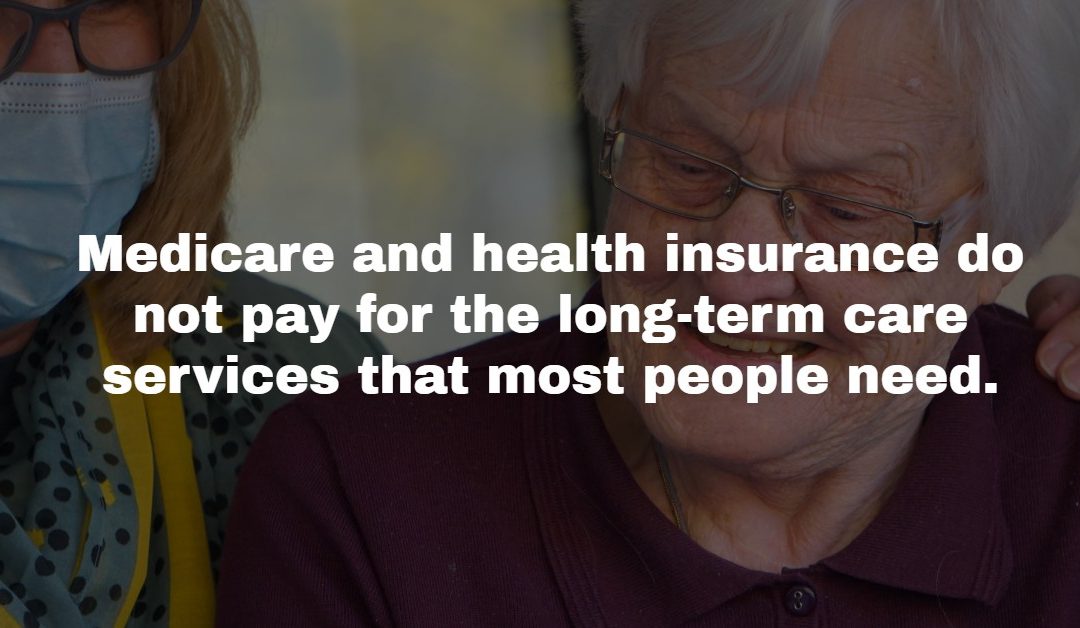At least 70 percent of people over age 65 will require some long-term care services at some point in their lives. Contrary to what many people believe, Medicare and health insurance do not pay for the long-term care services that most people need. With the Deficit Reduction Act of 2005, the federal government made it abundantly clear that there’s a movement to make long-term care more of an individual’s problem and less of a government problem.
With the increase in number of people (baby boomers) seeking long term care and the changing nature of retirement resources from defined benefit (pensions) to defined contribution (401k’s), rapid expansion of reverse mortgages, and low savings rate in 401k and IRA’s, the long term care needs of baby boomers have the potential to overwhelm Medicaid’s pay-as-you-go financing.
Long Term Care Insurance
Long term care insurance, generally, is a form of private insurance that covers various long term care services, which can be sold individually or through a group, and is designed for middle and upper income individuals who want to protect considerable financial assets and have the means to pay the insurance premiums. Policy types and premiums can vary by age, health status, and gender. Policies vary by length of coverage, types of services covered (nursing home, assisted living, home-based, community-based).
This particular program is meant to reduce demand for public funds and ultimately save Medicaid dollars while encouraging people to look at future costs and plan for those long term care costs, and any delay in a person going onto Medicaid is a substantial savings for the state, so policies of this type are encouraged through this program.
The partnership program was originally started in four states (CA, CT, IN, and NY), and it was funded by the Robert Wood Johnson Foundation in 1988. The purpose was to slow the growth of Medicaid expenditures. The Omnibus Budget Reconciliation Act of 1993 restricted additional growth of this program, but in 2005, a federal law was passed which permitted these programs as long as a state plan amendment which met certain criteria was passed at the state level.
The North Carolina Long-Term Care Partnership Program
The North Carolina Long-Term Care Partnership Program was authorized in 2010 under N.C. Gen. Stat. 108A-70.4. The North Carolina Long-Term Care Partnership Program encourages the purchase of long-term care insurance and is aimed at middle and upper income individuals.
Policy holders who purchase a qualified North Carolina Long-Term Care Partnership Program insurance policy, and then exhaust that coverage, can become eligible for Medicaid with a larger amount not counting against them of their own assets. The purpose of the North Carolina Long-Term Care Insurance Partnership program is to make the purchase of shorter term, more comprehensive, long-term care insurance meaningful by linking such policies with Medicaid for those who require ongoing care beyond the amount of insurance purchased.
Under the Deficit Reduction Act of 2005, states were encouraged to adopt Long-Term Care Partnership Programs. Under the legislation passed in 2010, North Carolina authorized its own Long-Term Care Partnership Program.
In order to qualify as a Partnership Policy under the North Carolina Long-Term Care Partnership Program, the policy must adhere to several specific requirements, including the following:
1. The policy must be a tax-qualified policy; 2. The policy has to contain specified inflation protection if sold to an individual under age 76; 3. The policy must adhere to certain consumer protection requirements; 4. The insured must be a resident of North Carolina when the benefits are claimed.
If you are interested in purchasing a Partnership Policy, you can get more information about participating insurance companies authorized by the North Carolina Department of Insurance to market and sell these policies to NC residents. These companies are listed on the NC Department of Insurance website, under the SHIIP program (State Health Insurance Information Program).
Keep in mind that if you use the North Carolina Long-Term Care Partnership Program, Medicaid Estate Recovery may include a greater portion of your assets. Generally speaking, Medicaid Estate Recovery is limited in the assets that it can claim at your death to reimburse itself for expenses incurred for your long term care.
However, if you use this program, additional assets may be made available to the claws of the Medicaid program. This might make jointly owned real estate, for example, subject to a forced sale to repay Medicaid. To that point though, you will have asset protection up to the amount paid on your behalf by the partnership policy, so it may be a tradeoff worth taking.
Asset Disregard
If you have one of these policies, you fall into a special category of applicants that get a special feature called an “asset disregard,” which otherwise you would have had to spend down to qualify for Medicaid. An amount equal to the benefits received is disregarded from your assets. Since these policies must include inflation protection, the amount of the benefits you receive can be higher than the amount of insurance protection you originally purchased.
Typically, you would need less than $2,000 of countable assets to be eligible for Medicaid (somewhat higher for married couples). If you purchase a policy of this type, it’s possible that you could exclude hundreds of thousands in assets that you might not otherwise be able to exclude.
While our firm does a lot of planning with other tools, such as a trust, those tools are not perfect for everyone. For example, a common tool we use for planning for Medicaid eligibility is to create an irrevocable trust. However, with a 60 month look back period, that may not be the optimal solution for people who think they may need care sooner or aren’t sure.
Under the North Carolina Long-Term Care Partnership Program, personal assets in the amount of the total benefits paid are disregarded when Medicaid asset eligibility is calculated. For each dollar of benefits paid by a qualifying policy, one dollar of assets is not counted toward the eligibility limit. This means you get to keep those assets and don’t have to spend them before qualifying for Medicaid.
With a Partnership policy, it also means that the state will not seek to recover money spent for your care from your estate. Estate recovery means that the state can require repayment from your estate for any costs paid by Medicaid. Too often, the family
If you have one of these policies, then at the time of applying for Long Term Care Medicaid, the amount paid out by the insurance company will be counted as an offset from both the amount of spend-down needed to qualify for Long Term Care Medicaid and will protect the same amount of property from Estate Recovery after you pass away.
The policies, under NC rules, have to state that if the insured is already a beneficiary of long term care Medicaid, the policy will not allow a resource disregard and protection at estate recovery, and have to state that the purchase of a partnership policy does not guarantee qualification for Medicaid.
Only the available and countable assets of the Medicaid applicant, and their share of the jointly owned assets can be protected in this manner. It is also possible to use a policy purchased in another state if that state has a reciprocal agreement with NC. Only a handful of states are excluded from such list.
If you need help with long term care planning, Medicaid eligibility, or Medicaid Estate Recovery matters, please reach out to our team at Hopler, Wilms, & Hanna.


